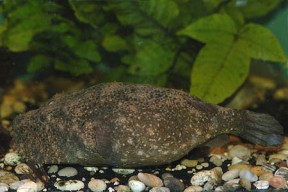Tetraodon baileyi
Hairy Puffer
Classification
Tetraodontidae
Distribution
Thailand and Laos.
Habitat
Inhabits rocky areas of large rivers, including areas of whitewater.
Maximum Standard Length
4.8″ (12cm) is the official figure, although it’s reported to grow much larger.
Aquarium SizeTop ↑
30″ x 12″ x 12″ (75cm x 12cm x 12cm) – 70 litres.
Maintenance
A biotope aquarium would consist of a sandy substrate littered with smooth, water worn rocks. Arrange these to provide some hiding places for the fish, and try to provide a moderate current through the tank. It can also be kept in planted aquaria as it will not chew leaves.
Water Conditions
Temperature: 74-81°F (23-27°C)
pH: No precise details available, although at least one batch of fish was collected in water of around neutral pH. Assume a range between 6.5-7.5.
Hardness: Again, no accurate data is available. Somewhere between 5-12°H is suggested.
Diet
Relishes all kinds of shellfish, as well as worms and other live and frozen foods. It should be fed snails and unshelled shellfish (such as crab legs, mussels etc.) regularly, in order to maintain it’s sharp teeth. As with other puffers, these grow continuously and become a problem for the fish if they are not kept ground down.
Behaviour and CompatibilityTop ↑
A generally aggressive and intolerant species that really should be kept alone. Its beak-like mouth can easily bite chunks from other fish, or in extreme cases rip them to pieces. It’s also very aggressive towards conspecifics and should never be kept in groups.
Sexual Dimorphism
Males are said to have a greater number of cirri (the hair-like growths that characterise this species) than females, but this is unconfirmed as others report that females do not possess cirri at all.
Reproduction
Not thought to have been achieved in aquaria, probably due to its temperament (and pricetag!) restricting the number of hobbyists prepared to make a serious attempt.
NotesTop ↑
Puffer fish are so called as they have the ability to inflate their elastic stomachs with water or air. This is usually a response to some kind of threat, although in the aquarium many specimens appear to inflate themselves for no apparent reason. The fish becomes 2 or 3 times it’s normal size, which makes the fish both big enough to scare away many potential predators, and difficult to swallow.
Many parts of the body of puffers contain the deadly neurotoxin tetrodoxin. This is the same poison found in the notorious blue-ringed octopus. When ingested in sufficient quantities, it can cause paralysis and death. As yet there is no known antitoxin and to humans it is over 1000 times deadlier than cyanide. Grotesquely, the victim usually remains conscious as he or she becomes paralysed. It’s a famous delicacy in Japan, but is prepared only by highly-trained chefs, and even then many people have died from eating it.
The hairy puffer is rare in the hobby, and tends to command a relatively high price when it is available. The exact nature of the cirri that cover the fish is unknown, but would appear to be related to gender, or possibly camouflage. It can change colour depending on its mood, and, uniquely among puffers, is completely scaleless.


